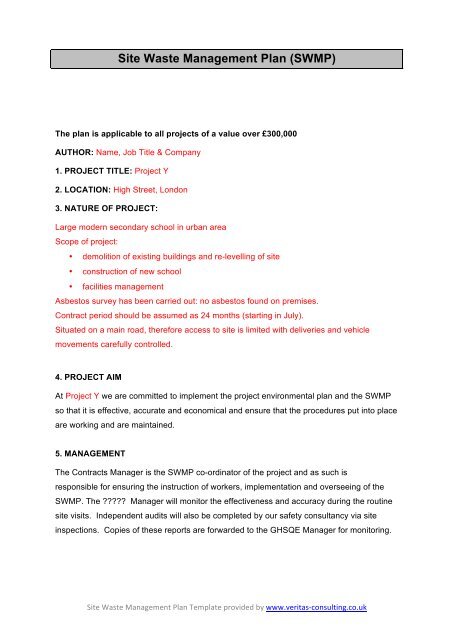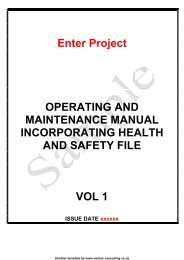Site Waste Management Plan (SWMP) - Health and Safety ...
Site Waste Management Plan (SWMP) - Health and Safety ...
Site Waste Management Plan (SWMP) - Health and Safety ...
Create successful ePaper yourself
Turn your PDF publications into a flip-book with our unique Google optimized e-Paper software.
<strong>Site</strong> <strong>Waste</strong> <strong>Management</strong> <strong>Plan</strong> (<strong>SWMP</strong>)<br />
The plan is applicable to all projects of a value over £300,000<br />
AUTHOR: Name, Job Title & Company<br />
1. PROJECT TITLE: Project Y<br />
2. LOCATION: High Street, London<br />
3. NATURE OF PROJECT:<br />
Large modern secondary school in urban area<br />
Scope of project:<br />
• demolition of existing buildings <strong>and</strong> re-levelling of site<br />
• construction of new school<br />
• facilities management<br />
Asbestos survey has been carried out: no asbestos found on premises.<br />
Contract period should be assumed as 24 months (starting in July).<br />
Situated on a main road, therefore access to site is limited with deliveries <strong>and</strong> vehicle<br />
movements carefully controlled.<br />
4. PROJECT AIM<br />
At Project Y we are committed to implement the project environmental plan <strong>and</strong> the <strong>SWMP</strong><br />
so that it is effective, accurate <strong>and</strong> economical <strong>and</strong> ensure that the procedures put into place<br />
are working <strong>and</strong> are maintained.<br />
5. MANAGEMENT<br />
The Contracts Manager is the <strong>SWMP</strong> co-ordinator of the project <strong>and</strong> as such is<br />
responsible for ensuring the instruction of workers, implementation <strong>and</strong> overseeing of the<br />
<strong>SWMP</strong>. The ????? Manager will monitor the effectiveness <strong>and</strong> accuracy during the routine<br />
site visits. Independent audits will also be completed by our safety consultancy via site<br />
inspections. Copies of these reports are forwarded to the GHSQE Manager for monitoring.<br />
<strong>Site</strong> <strong>Waste</strong> <strong>Management</strong> <strong>Plan</strong> Template provided by www.veritas-‐consulting.co.uk
<strong>Site</strong> <strong>Waste</strong> <strong>Management</strong> <strong>Plan</strong> (<strong>SWMP</strong>)<br />
Position Name Contact Details<br />
Client<br />
Construction Director<br />
Contracts Manager<br />
<strong>Site</strong> Manager<br />
HSQE Manager<br />
Document Controller<br />
TBA<br />
Head Quarters<br />
Head Quarters<br />
Project Office<br />
Project Office<br />
Head Quarters<br />
6. DISTRIBUTION<br />
The Contract Manager shall distribute copies of this plan to the CDM Co-ordinator, Client,<br />
<strong>Site</strong> Manager <strong>and</strong> each Subcontractor where relevant/applicable. This will be undertaken<br />
every time the plan is updated.<br />
7. INSTRUCTION <strong>and</strong> TRAINING<br />
The Contract Manager will provide on-site briefing via induction of appropriate separation,<br />
h<strong>and</strong>ling, recycling, reuse <strong>and</strong> return methods to be used by all parties <strong>and</strong> at appropriate<br />
stages of the Project where applicable. Toolbox talks will be carried out regularly on waste<br />
issues <strong>and</strong> all subcontractors will be expected to attend. This will ensure that everyone feels<br />
they are included <strong>and</strong> that their participation is meaningful.<br />
8. WASTE MANAGEMENT ON SITE<br />
Surplus or waste materials arise from either the materials imported to site or from those<br />
generated on site. Imported materials are those, which are brought to the project for<br />
inclusion into the permanent works. Generated materials are those, which exist on the<br />
project such as topsoil, sub-soil, trees <strong>and</strong> materials from demolition works etc.<br />
However, there are other considerations to waste management such as waste reduction,<br />
segregation of waste, disposal of waste, financial impacts of waste disposal <strong>and</strong> recording,<br />
monitoring, education <strong>and</strong> reviewing. This plan outlines the procedures that have been put in<br />
to place <strong>and</strong> demonstrate how they benefit the environment, how we can measure the<br />
effects <strong>and</strong> how these procedures <strong>and</strong> practices are sustainable.<br />
<strong>Site</strong> <strong>Waste</strong> <strong>Management</strong> <strong>Plan</strong> Template provided by www.veritas-‐consulting.co.uk
<strong>Site</strong> <strong>Waste</strong> <strong>Management</strong> <strong>Plan</strong> (<strong>SWMP</strong>)<br />
PRIORITISING WASTES REQUIRING WASTE MANAGEMENT ENABLING WORKS<br />
(including DEMOLITION): <strong>Waste</strong> Type, Category <strong>and</strong> Origin<br />
<strong>Waste</strong> Types <strong>Waste</strong><br />
European <strong>Waste</strong> Colour Codes<br />
Origin of <strong>Waste</strong><br />
eg bricks<br />
Codes EWC<br />
Demolition of existing<br />
Category<br />
buildings & walls.<br />
Concrete Inert 17 01 06 <strong>Site</strong> Strip & Demolition<br />
Tarmac Inert 17 03 01 <strong>Site</strong> Strip<br />
Brick/Block Inert 17 01 06 <strong>Site</strong> Strip & Demolition<br />
Timber Active/bio 17 02 01 Demolition Works<br />
Subsoils Inert 17 05 04 <strong>Site</strong> Strip<br />
Subsoils Hazard 17 05 03 <strong>Site</strong> strip<br />
Metals Active/Bio 17 04 07 <strong>Site</strong> Strip & Demolition<br />
Asbestos Hazardous 17 06 05 Demolition Works<br />
Plasterboard Active/Bio 17 08 02 Demolition Works<br />
Packaging 15 01 01 see note 1<br />
Construction<br />
15 01 02 see note 2<br />
15 01 03 see note 3<br />
Mixed 17 09 04 Construction &<br />
Demolition<br />
NOTE 1 15 01 01 is the EWC code for paper & cardboard packaging<br />
NOTE 2 15 01 02 is the EWC code for plastic packaging<br />
NOTE 3 15 01 03 is the EWC code for wooden packaging<br />
9. WAYS OF MINIMISING WASTE<br />
At Project Y we have, from a very early stage, looked at how we can minimise the waste<br />
produced, thereby reducing the amount of waste to be removed from the project. Trade<br />
Contractors, Design Team <strong>and</strong> Suppliers are all being encouraged to look at ways to<br />
minimize the amount of waste produced at the work face.<br />
<strong>Site</strong> <strong>Waste</strong> <strong>Management</strong> <strong>Plan</strong> Template provided by www.veritas-‐consulting.co.uk
<strong>Site</strong> <strong>Waste</strong> <strong>Management</strong> <strong>Plan</strong> (<strong>SWMP</strong>)<br />
Current Actions Table<br />
Action Responsibility Date Action<br />
Commenced<br />
Plasterboard sheets are made Design Team<br />
to st<strong>and</strong>ard sizes to suit the<br />
wall heights <strong>and</strong> to reduce the<br />
amount of off cuts/waste.<br />
The wash down point for the Principal Contractor<br />
concrete wagons is in a<br />
suitable location so that the<br />
washed out aggregates<br />
formed part of the fill.<br />
Substructure - when the bases Construction Manager<br />
are being poured that we had Principal Contractor<br />
other bases excavated<br />
Manager so that any surplus<br />
concrete could be utilised as<br />
blinding.<br />
Materials, which arrive on<br />
pallets, are unloaded <strong>and</strong> the<br />
pallets are stored neatly <strong>and</strong><br />
removed from site once the<br />
numbers are sufficient to make<br />
collection economical.<br />
Apply all identified<br />
environmental risk & actions<br />
identified in the CPHSP<br />
<strong>Site</strong> Foreman<br />
Principal Contractor<br />
Operatives<br />
<strong>Site</strong> Manager<br />
Trade contractors<br />
How notified<br />
CPHSP/<br />
Meetings<br />
CPHSP<br />
Construction<br />
Phase <strong>Health</strong> &<br />
<strong>Safety</strong> <strong>Plan</strong><br />
CPHSP<br />
CPHSP<br />
Method<br />
statements<br />
Risk<br />
Assessments<br />
CPHSP<br />
All of the above act to reduce the amount of waste <strong>and</strong> surplus materials, which traditionally<br />
would be skipped <strong>and</strong> sent to l<strong>and</strong>fill. We are continually identifying waste minimisation<br />
actions <strong>and</strong> these will be updated in the above table.<br />
<strong>Site</strong> <strong>Waste</strong> <strong>Management</strong> <strong>Plan</strong> Template provided by www.veritas-‐consulting.co.uk
<strong>Site</strong> <strong>Waste</strong> <strong>Management</strong> <strong>Plan</strong> (<strong>SWMP</strong>)<br />
10. SEGREGATION<br />
A specific area shall be laid out <strong>and</strong> labelled to facilitate the separation of materials for<br />
potential recycling, salvage, reuse <strong>and</strong> return. Recycling <strong>and</strong> waste bins are to be kept clean<br />
<strong>and</strong> clearly marked in order to avoid contamination of materials. The labelling systems shall<br />
be the <strong>Waste</strong> Awareness Colour Coding Scheme. If the skips are clearly identified the bulk<br />
of the workforce will deposit the correct materials into the correct skip. Skips for segregation<br />
of waste identified currently are:<br />
• Wood<br />
• Metal<br />
• Brick/rubble<br />
• Canteen waste<br />
As works progress <strong>and</strong> other trades come to site other skips will be placed to enable certain<br />
waste to be removed from site. This is likely to include:<br />
• Plasterboard<br />
• Paper <strong>and</strong> cardboard (bagged up)<br />
11. MANAGEMENT<br />
<strong>Waste</strong> materials fall into three categories for management, these are:<br />
• Re-use<br />
• Recycle<br />
• L<strong>and</strong>fill<br />
Re-used<br />
If surplus materials can be used in the permanent works they are classified as materials,<br />
which have been re-used. If they are surplus to requirements <strong>and</strong> need to be removed from<br />
site <strong>and</strong> they can be removed <strong>and</strong> used in their present form, they can be removed from site<br />
for reuse.<br />
Recycling<br />
If the surplus material cannot be re-used in its present form but could be used in a different<br />
form, it is sent for recycling such as 50x50 timber to make chipboard.<br />
L<strong>and</strong>fill<br />
If either of the above cannot be satisfied then the only option left is to send the surplus<br />
materials to l<strong>and</strong>fill. At Project Y l<strong>and</strong>fill is always a last resort.<br />
<strong>Site</strong> <strong>Waste</strong> <strong>Management</strong> <strong>Plan</strong> Template provided by www.veritas-‐consulting.co.uk
<strong>Site</strong> <strong>Waste</strong> <strong>Management</strong> <strong>Plan</strong> (<strong>SWMP</strong>)<br />
WASTE MANAGEMENT CYCLE<br />
TABLE FOR WASTE TYPES & WASTE MANAGEMENT PACKAGES<br />
<strong>Waste</strong> Types<br />
Enabling Works (including Demolition)<br />
Concrete<br />
Tarmac<br />
Bricks/blocks<br />
Timber<br />
Subsoils<br />
Metals<br />
Asbestos<br />
Plasterboard<br />
Construction Works<br />
Plasterboard<br />
Bricks/blocks<br />
Timber<br />
Cardboard<br />
Mortar<br />
Metals<br />
Paints<br />
Soils<br />
<strong>Waste</strong> Stream<br />
Re-use onsite<br />
Re-use onsite/dry<br />
Re-use onsite<br />
Recycle<br />
Re-use onsite/recycle<br />
Scrap Value<br />
No usage/L<strong>and</strong>fill<br />
Return/recycle/L<strong>and</strong>fill<br />
Return/recycle<br />
Recycle<br />
Recycle<br />
Recycle<br />
No usage/dry to skip<br />
Recycle<br />
Recycle<br />
Use/sell<br />
<strong>Site</strong> <strong>Waste</strong> <strong>Management</strong> <strong>Plan</strong> Template provided by www.veritas-‐consulting.co.uk
<strong>Site</strong> <strong>Waste</strong> <strong>Management</strong> <strong>Plan</strong> (<strong>SWMP</strong>)<br />
The skips need to be monitored to ensure that contamination of segregated skips does not<br />
occur. Therefore we will advise regularly on how the waste management system is working<br />
<strong>and</strong> point out that an uncontaminated skip for recycling costs typically £55 but should it get<br />
contaminated then it has to go direct to l<strong>and</strong>fill at a cost of typically £89 per skip <strong>and</strong> this<br />
price is continually increasing.<br />
We will continually review the type of surplus materials being produced <strong>and</strong> where we can<br />
change the site set up to maximise on re-use or recycling <strong>and</strong> the use of l<strong>and</strong>fill will be the<br />
last resort.<br />
The plan will be communicated to the whole project team (including the client) at the<br />
regularly. Business wide updates including the KPIs will be communicated <strong>and</strong> discussed at<br />
IMS <strong>and</strong> <strong>Management</strong> meetings<br />
The plan will also be analysed by the Group HSQE Manager to produce KPIs <strong>and</strong> will be<br />
responsible for transferring <strong>and</strong> advising any best practice <strong>and</strong> solutions throughout the<br />
company. Our prequalification process identifies compliant waste management companies<br />
with records maintained on file.<br />
SITE WASTE MANAGEMENT PLAN (<strong>SWMP</strong>) IMPLEMENTATION CHECKLIST<br />
Checks – please tick √ yes or no Yes No<br />
Have terms <strong>and</strong> commercial rates been agreed with contractor(s)?<br />
√<br />
For offsite or disposal are all the waste destination details verified?<br />
√<br />
Has a waste segregation / collection area been prepared?<br />
√<br />
Has the waste area been adequately sign posted?<br />
√<br />
Has the <strong>SWMP</strong> document control / filing system been set up (site safety pack)?<br />
√<br />
Have all necessary staff <strong>and</strong> contractors had the <strong>SWMP</strong> transmitted?<br />
√ <br />
Have all the <strong>SWMP</strong> training / induction procedures for staff been met?<br />
√ <br />
Have all the <strong>SWMP</strong> training / induction procedures for contractor/s been met?<br />
√ <br />
Has the <strong>SWMP</strong> been approved by the Contracts Manager?<br />
√ <br />
Comments / Further Actions:<br />
Include <strong>Waste</strong> <strong>Management</strong> <strong>Plan</strong> within Tender Documentation/ CPHSP<br />
<strong>Site</strong> <strong>Waste</strong> <strong>Management</strong> <strong>Plan</strong> Template provided by www.veritas-‐consulting.co.uk
<strong>Site</strong> <strong>Waste</strong> <strong>Management</strong> <strong>Plan</strong> (<strong>SWMP</strong>)<br />
RELEVANT SIGNATURES<br />
Contracts Manager:<br />
Date:<br />
<strong>Site</strong> Manager:<br />
Date:<br />
<strong>Site</strong> <strong>Waste</strong> <strong>Management</strong> <strong>Plan</strong> Template provided by www.veritas-‐consulting.co.uk




